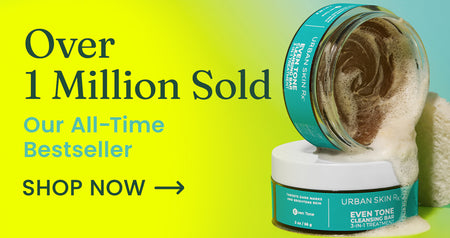Lactic Acid vs. Glycolic Acid: Which Is Best for My Skin?

When it comes to choosing the best products for your unique skin concerns and needs, Lactic Acid and Glycolic Acid are two popular skincare ingredients — and for a good reason.
However, determining which of these two acids may be better suited to your skin can be a difficult feat. Read on as we explore Lactic Acid, Glycolic Acid and how you can determine which one is best for your skin.
What Is Lactic Acid?
Lactic Acid is a chemical exfoliant that is made from fermented lactose, which is a carbohydrate naturally present in milk. Lactic Acid is mainly available over-the-counter or in prescription-strength formulas and has become a common and popular inclusion in many skincare products.
Lactic Acid is a member of the Alpha Hydroxy Acid (AHA) family, which also includes Glycolic and Mandelic Acids. AHAs are water-soluble chemical compounds that provide remarkable skin benefits when used in cosmetic compositions.
AHAs are natural acids that can be derived from plants, and they are beneficial because they are made of molecules small enough for your skin to absorb easily. This means that AHAs can be highly effective at reducing the appearance of fine lines or wrinkles, smoothing the look of skin texture and overall improving and brightening your complexion.
Lactic Acid has an extra benefit that other AHAs do not have — it not only improves the overall look of the skin but also keeps it moisturized. Nothing like taking care of two skin needs at once!
What Are the Key Benefits of Lactic Acid?
Lactic Acid brings a lot to the table and can have a wide range of benefits. Some potential skin benefits of Lactic Acid can include:
- Boosting even-looking skin tone
- Smoothing the look of skin texture
- Minimizing the appearance of dark patches
- Reducing the appearance of fine lines and wrinkles
- Cleaning and clearing pores
With benefits like this, who wouldn’t want to give Lactic Acid a try? However, Glycolic is spectacular as well. Read more to learn about its benefits.
What Is Glycolic Acid?
Glycolic Acid is just one example of a water-soluble Alpha Hydroxy Acid (AHA), and it is made from sugar cane. Glycolic Acid has quickly become one of the most popular AHAs incorporated into skincare formulas, and it may provide a wide range of benefits.
What Are the Main Benefits of Glycolic Acid?
Like Lactic Acid, Glycolic Acid has many potential benefits. A few of these include:
- Smoothing the appearance of fine lines
- Improving and supporting healthy skin texture
- Reducing the appearance of scarring
- Reducing the appearance of spotting (like sunspots)
Glycolic Acid can help bring more clarity and brightness to the skin. If you have spots or scarring that you would like to reduce the appearance of, Glycolic Acid could be right for you!
Which Acid Is Better Overall?
You might be wondering how to pick between these two ingredients for your skincare regimen. The answer is contingent on your skin's sensitivity and how quickly you want to see the effects of your skincare routine.
It's important to remember that Glycolic Acid has a low molecular weight, meaning it easily gets through your skin barrier to work its magic from the inside out. As a consequence, Glycolic Acid may produce quicker results.
Glycolic Acid, however, may be more likely to irritate sensitive skin and cause increased sun sensitivity. Tingling, dryness, peeling and even burning may occur, in which case we recommend pausing your usage and consulting your dermatologist for advice.
Which Acid Is More Gentle?
If you want to choose a more gentle route, you may want to try Lactic Acid. Lactic Acid can help reduce dark spots and smooth the look of your skin.
Lactic Acid is slower to act than Glycolic Acid, which may be a disadvantage. Even so, it's a very effective chemical exfoliant, and its slow-acting abilities make it easier on sensitive skin.
Which Acid Is Best for Which Skin Type?
Glycolic Acid may be better tolerated by normal to oily skin types, and is often advised for uneven skin texture since it may penetrate deeper into the skin layer.
Lactic Acid, on the other hand, is a milder exfoliant that can be ideal for dry or sensitive skin. Because of its higher molecular weight and moisturizing characteristics, it has a lower risk of causing skin irritation.
Always do a patch test to evaluate how a new skincare ingredient affects your skin, and then apply it to your face once you are certain there is no negative reaction. With any new product or ingredient, we recommend starting slow with lower concentrations and gradually working your way up to more potent products.
Can Lactic and Glycolic Acid Be Used Together?
Technically, the answer is yes. After all, there are many products on the market that include both acids.
However, keep in mind that utilizing both acids simultaneously may cause skin sensitivity or irritation, particularly if your skin is dry or sensitive in the first place. This may be especially true if you are using Lactic Acid or Glycolic Acid for the first time.
What Products From Urban Skin Rx® Include Lactic Acid?
Here are a few of our products that are mindfully formulated with Lactic Acid:
-
Super C Brightening Serum - Our Super C Brightening Serum is an antioxidant powerhouse that will brighten the look of aging skin, dark spots and uneven skin tone.
-
Advanced Even Tone Day & Night Treatment - This Hydroquinone-free Pro Strength™ product contains 3% Tranexamic Acid to address hyperpigmentation softly and efficiently at all hours of the day and night.
- Radiant & Bright Glowing Moisturizer - This moisturizer not only hydrates your skin day and night, but it also contains Antioxidants and Vitamins to improve the appearance of dull skin and rough texture, giving you an instant healthy glow!
Whether you choose a cleanser, moisturizer or serum, count on our products featuring innovative formulas to boost brightness, clarify the skin and even the look of skin tone.
What Products From Urban Skin Rx® Include Glycolic Acid?
Here are just three of our products that feature Glycolic Acid. There are quite a few to choose from! Plus, we value providing different options for every skin type and concern.
- Clear Skin Cleansing Bar - Our best-selling daily cleanser, mask and exfoliator for oily skin, this clear skin cleanser in a jar is developed to help with breakouts and post-inflammatory hyperpigmentation.
-
Reti-Glow™ Gentle Resurfacing Night Oil - This night oil is great for sensitive skin types that wish to smooth rough texture, even out skin tone and fight aging as they sleep!
- Retinol Rapid Repair & Dark Spot Treatment - Improves the appearance of hyperpigmentation, aging skin, uneven skin tone, post-breakout scars, dark spots and fine lines and wrinkles.
Glycolic Acid is great for resurfacing, helping with a more balanced complexion and improving the look of dark spots. How to Introduce Lactic and Glycolic Acid to Your Routine Now that you know all the basics about Lactic Acid and Glycolic Acid, it’s time to add these powerhouse ingredients to your skincare routine! Here are a few ways to get started.
Target the Issues
Begin by defining your aesthetic concerns or skin issues. For example, maybe you love your freckles but not your breakouts or age spots. Then, it’s important to identify what skin type you have. Is your skin normal, oily, dry or a combination? Next, you’ll want to research both acids as your skin could be sensitive to either.
Add Gradually
Last but not least, raise the acid concentration gradually. This is to allow your skin to adjust to the new environment. Learn which skincare products work well with Glycolic and Lactic Acids and which ones don't. After a session of chemical exfoliation, don't forget to apply sunscreen!
In Conclusion
Your skin could benefit from Lactic or Glycolic Acid. It may be about preference or meeting your skin’s needs. Some may say that Lactic Acid is a gentler exfoliant for your skin, but your skin could prefer Glycolic Acid, which is best for uneven skin texture, such as acne scars and wrinkles.
Although the two ingredients can be used together if you please, it’s wise to slowly move into using each product, especially when using the two together. You wouldn’t want to overwhelm your skin by using the two together.
All in all, make sure that you take good care of your skin and don’t rush to fix a skincare need. We’re here to help and cheer you on in your skincare journey. Check us out, and reach out to our Licensed Aestheticians with any questions or concerns.
We’ve got the best for your skin in mind. Schedule a virtual consultation or take our skincare quiz today.
Service Representative




